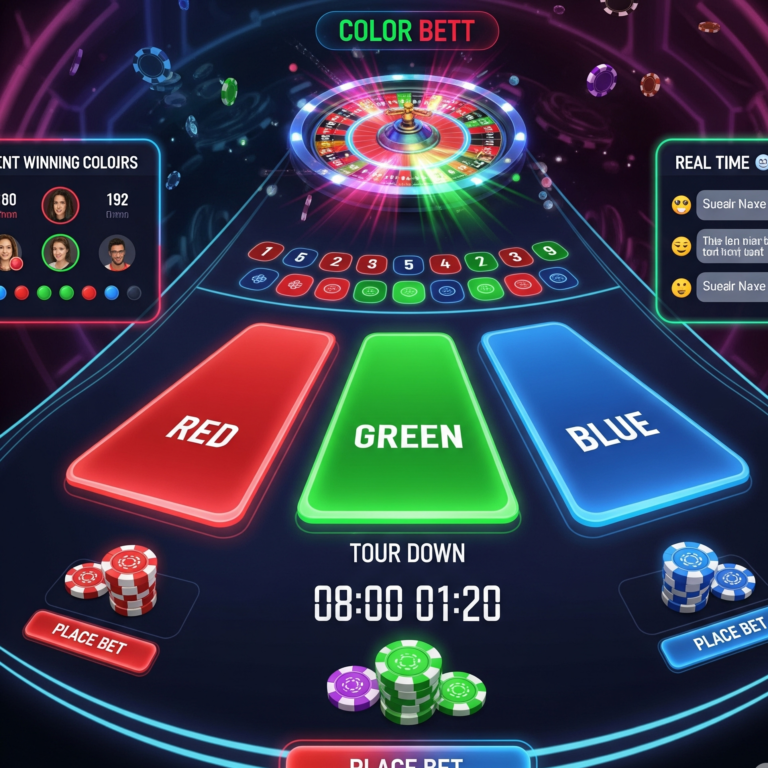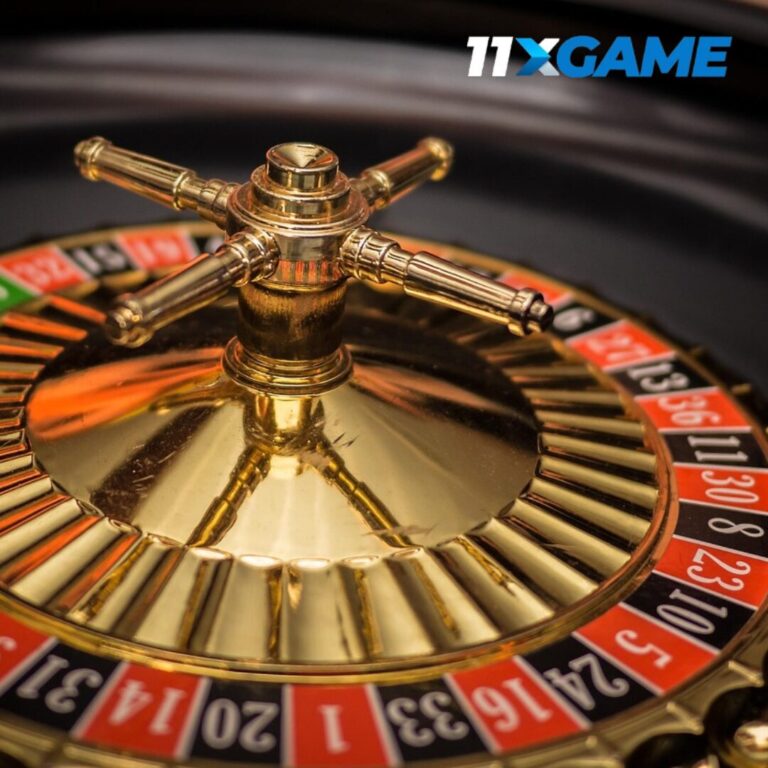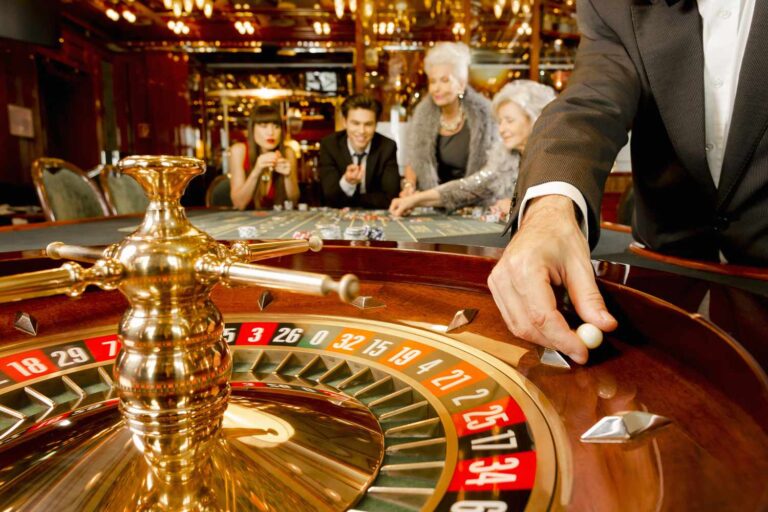Mastering When to Hit, Stand, Split, or Double: 10 Game-Changing Strategies for Blackjack Triumph
When to hit, stand, split, or double in blackjack can make or break your session at the table. If you’ve ever sat down at a blackjack game feeling overwhelmed by the choices, you’re not alone. This classic casino game blends luck with skill, and knowing precisely when to make each move is the key to turning the odds in your favor. Whether you’re a newbie dipping your toes into online betting or a seasoned player looking to refine your approach, understanding these decisions is essential for long-term success.
In this comprehensive guide, we’ll dive deep into the art of blackjack decision-making. We’ll cover everything from basic rules to advanced tactics, real-life scenarios, and tips straight from the community. By the end, you’ll feel confident navigating any hand thrown your way. And if you’re ready to put these strategies into action, check out platforms like 11xgame.live where you can play blackjack with real stakes and exciting rewards. For more insights on betting games, explore our blog hub at 11xgame.org.
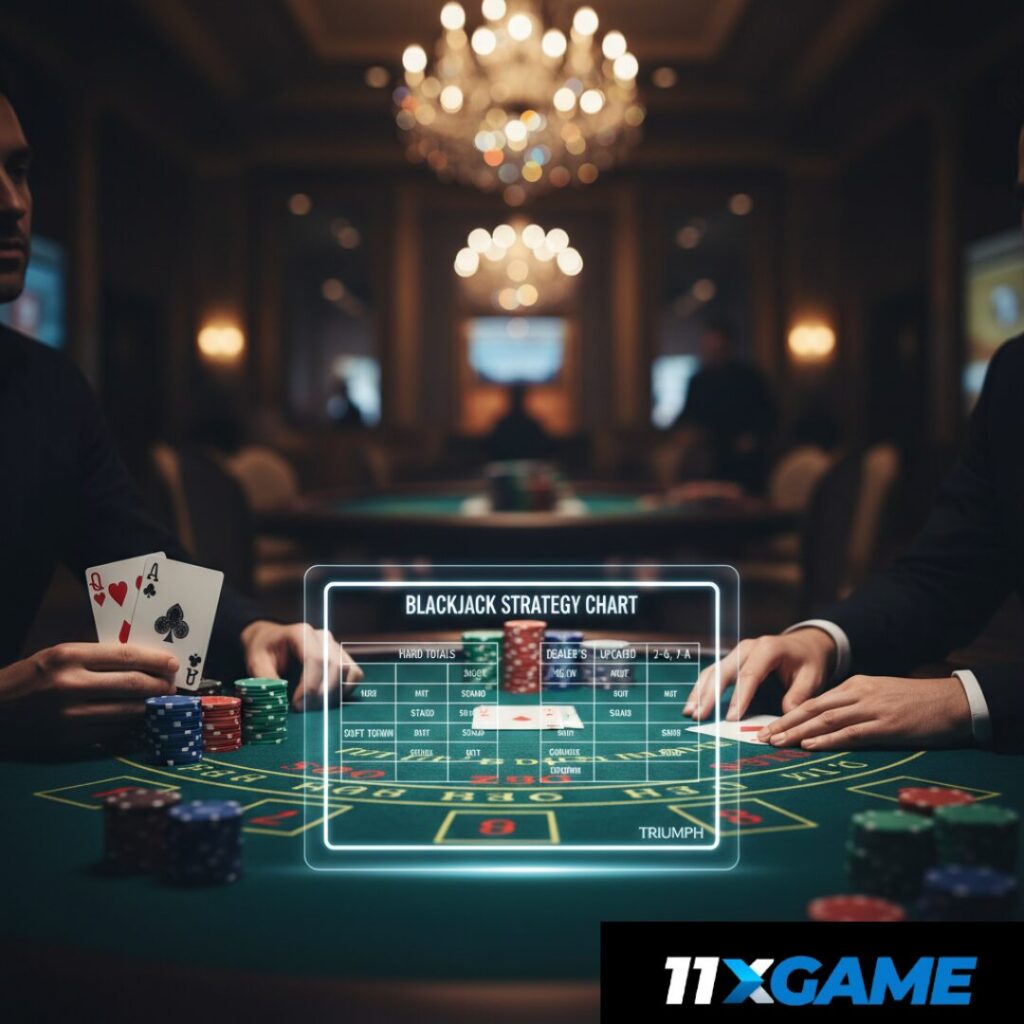
Understanding the Basics of Blackjack
Blackjack, also known as 21, is one of the most popular card games worldwide. The goal is simple: beat the dealer by getting a hand value closer to 21 without going over. Cards 2 through 10 are worth their face value, face cards (J, Q, K) are 10, and aces can be 1 or 11.
Each round starts with you receiving two cards, and the dealer gets one face up (the upcard) and one face down. Your options? That’s where when to hit, stand, split, or double comes into play. Hitting means taking another card, standing is staying with your current hand, splitting divides pairs into two hands, and doubling increases your bet for one more card.
Why does this matter? Because the house edge in blackjack is low—around 0.5% with perfect play. But poor decisions can spike it up to 2% or more. Stick around as we break it down.
What Does “Hit” Really Mean in Blackjack?
When to hit, stand, split, or double starts with hitting—the most aggressive move. You hit when your hand is weak and needs improvement, but you risk busting (going over 21).
For example, if you have a hard 12 (no ace) and the dealer shows a 7 or higher, hitting is often the way to go. Why? The dealer has a strong upcard, so you need to push your total higher to compete.
But timing is everything. Basic strategy charts, like those from trusted sources, guide these choices. They show that with a 16 against a dealer’s 10, you should hit—despite the bust risk—because standing leaves you vulnerable to the dealer’s likely strong hand.
Don’t overthink it early on. Practice on free modes at sites like 11xgame.vip to get a feel.
The Power of Standing: When to Hold Your Ground
Standing is the opposite of hitting—it’s saying, “I’m good with what I have.” When to hit, stand, split, or double often leans toward standing with strong hands like 17 or higher.
Imagine you have 18 and the dealer shows a 6. Standing here is smart because the dealer must hit until 17 or more, increasing their bust chance. Strategy pros emphasize this conservative play to minimize losses.
In multi-deck games (common online), stand on 12-16 if the dealer has 2-6. It’s counterintuitive, but math backs it up. Standing preserves your bankroll for better spots.
Splitting Pairs: Doubling Your Chances or Risks?
Splitting turns one hand into two, but only with pairs. When to hit, stand, split, or double includes always splitting aces and 8s—aces for the shot at two blackjacks, 8s because 16 is a loser hand.
Never split 10s; that’s a solid 20. For 6s or 7s, split against weak dealer cards (2-6). This move boosts your edge by creating more winning opportunities.
Real talk: Splitting wrong can cost you. Use charts to memorize—split 9s against 2-9 except 7, for instance. Try it out on 11xgame.club for low-stakes practice.
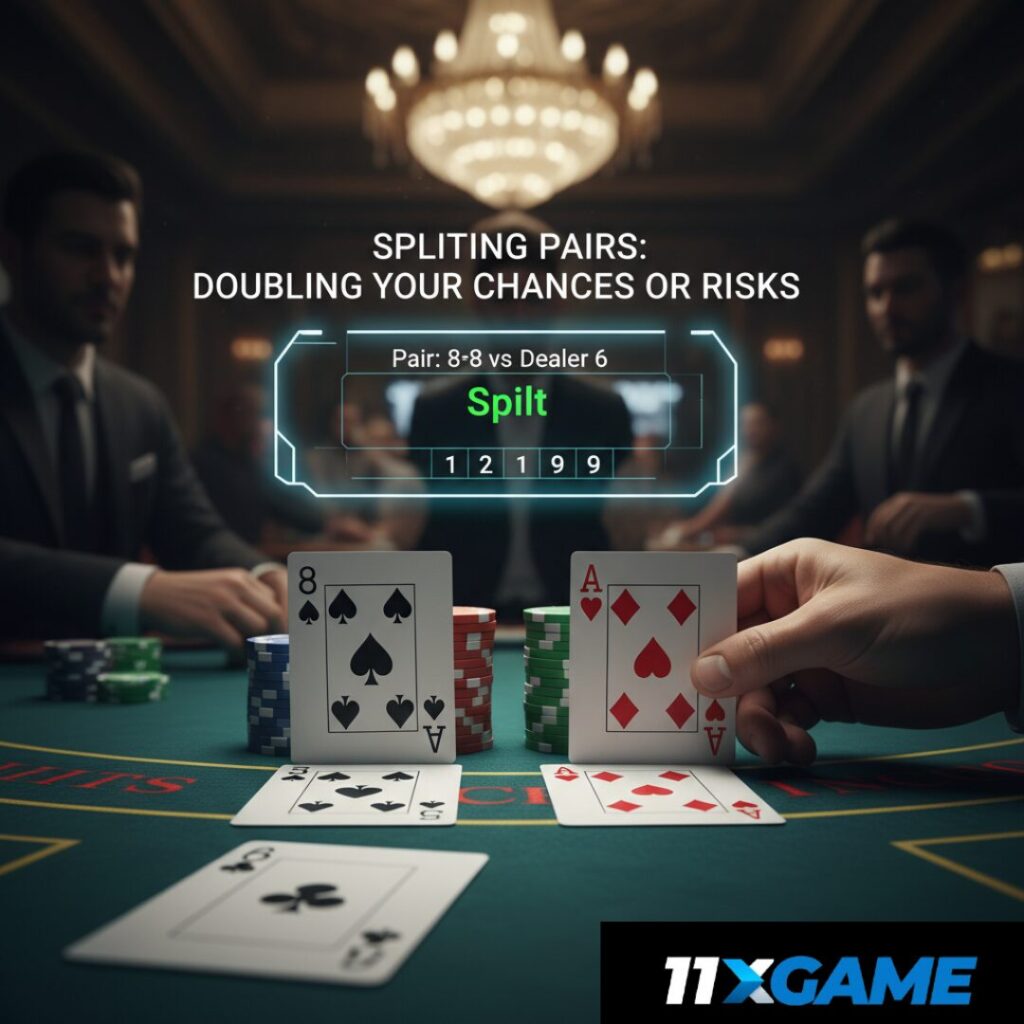
Doubling Down: High-Risk, High-Reward
Doubling down lets you double your bet after seeing your initial cards, but you get just one more card. When to hit, stand, split, or double shines here with hands like 11 against any dealer card (except ace in some variants).
Double on 10 against 2-9, or soft 16-18 against low cards. It’s aggressive, but when done right, it maximizes profits.
Caution: Not all games allow doubling after splits (DAS). Check rules on platforms like 11xgame.live to adapt.
Basic Strategy Charts: Your Roadmap to Success
No guesswork needed—basic strategy charts tell you exactly when to hit, stand, split, or double. Here’s a simplified one for 4-deck games where dealer hits soft 17.
Hard Totals Chart
| Your Hand | Dealer 2 | 3 | 4 | 5 | 6 | 7 | 8 | 9 | 10 | A |
| 5-8 | H | H | H | H | H | H | H | H | H | H |
| 9 | H | D | D | D | D | H | H | H | H | H |
| 10 | D | D | D | D | D | D | D | D | H | H |
| 11 | D | D | D | D | D | D | D | D | D | H |
| 12 | H | H | S | S | S | H | H | H | H | H |
| 13-16 | S | S | S | S | S | H | H | H | H | H |
| 17+ | S | S | S | S | S | S | S | S | S | S |
(Legend: H=Hit, S=Stand, D=Double)
Soft Totals Chart
| Your Hand | Dealer 2 | 3 | 4 | 5 | 6 | 7 | 8 | 9 | 10 | A |
| A2-A3 | H | H | H | D | D | H | H | H | H | H |
| A4-A5 | H | H | D | D | D | H | H | H | H | H |
| A6 | H | D | D | D | D | H | H | H | H | H |
| A7 | S | D | D | D | D | S | S | H | H | H |
| A8 | S | S | S | S | D | S | S | S | S | S |
| A9 | S | S | S | S | S | S | S | S | S | S |
Pair Splitting Chart
| Pair | Dealer 2 | 3 | 4 | 5 | 6 | 7 | 8 | 9 | 10 | A |
| 2-2 | Sp | Sp | Sp | Sp | Sp | Sp | H | H | H | H |
| 3-3 | Sp | Sp | Sp | Sp | Sp | Sp | H | H | H | H |
| 4-4 | H | H | Sp | Sp | Sp | H | H | H | H | H |
| 5-5 | D | D | D | D | D | D | D | D | H | H |
| 6-6 | Sp | Sp | Sp | Sp | Sp | H | H | H | H | H |
| 7-7 | Sp | Sp | Sp | Sp | Sp | Sp | H | H | H | H |
| 8-8 | Sp | Sp | Sp | Sp | Sp | Sp | Sp | Sp | Sp | Sp |
| 9-9 | Sp | Sp | Sp | Sp | Sp | S | Sp | Sp | S | S |
| 10-10 | S | S | S | S | S | S | S | S | S | S |
| A-A | Sp | Sp | Sp | Sp | Sp | Sp | Sp | Sp | Sp | Sp |
(Sp=Split)
These charts reduce the house edge dramatically. For more variations, visit 11xgame.org blogs on casino games.
Real Scenarios: Putting Strategy to the Test
Let’s bring when to hit, stand, split, or double to life with examples.
Scenario 1: You have 16, dealer shows 10. Chart says hit. You draw a 5—now 21! Dealer busts. Win!
Scenario 2: Pair of 8s vs. dealer 9. Split them. One hand gets 10 (18), other ace (19). Dealer has 19—push on one, win on other.
Scenario 3: Soft 18 vs. dealer 2. Double down. Draw 3—21. Dealer hits to 17. Double win!
These aren’t hypotheticals; they’re from actual plays on sites like 11xgame.vip. Remember, variance happens, but strategy wins long-term.
Common Mistakes When Deciding to Hit, Stand, Split, or Double
Even pros slip up. One big error: Standing on 12 vs. dealer 2-3. Charts say hit—dealer’s weak, but you need to improve.
Another: Not splitting 8s vs. ace. It feels safe, but math says split to avoid losing big.
Doubling too aggressively on soft hands without checking rules costs money. Always verify on 11xgame.club.
Avoid mimicking the dealer—hit soft 17 always if chart says so.
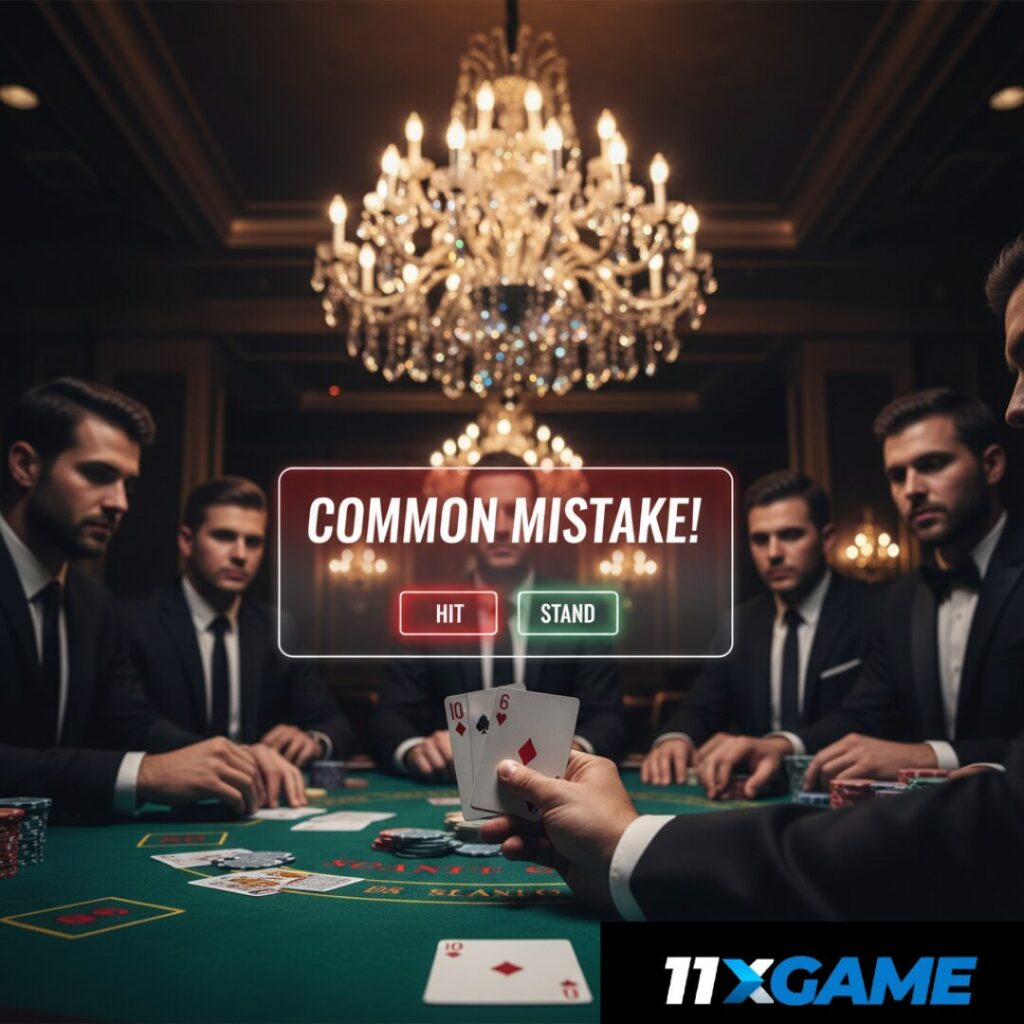
Advanced Tips for When to Hit, Stand, Split, or Double
Once basics are down, level up. In H17 games (dealer hits soft 17), stand more on soft 18 vs. ace.
Count cards? Basic strategy first. Use deviations like standing on 16 vs. 10 if count high.
Online? Look for live dealer games on 11xgame.live for authentic feel.
Bankroll management: Bet 1-2% per hand. For more on betting strategies, see 11xgame.org.
Community Insights: What Players Are Saying
From the betting community, insights abound. One X user shared: “Hit, Stand, Double Down or Split? Need some useful tips…” linking to a guide on strategies. Echoes the importance of charts.
Another tip from forums: “Always calculate implied odds before big moves,” akin to poker but applies here.
Players on socials rave about splitting aces: “Turned a losing session around!” Real voices confirm strategy works.
For community-driven blogs, head to 11xgame.org.
Highlights from Expert Strategies
- Always Split Aces: Potential for two blackjacks. 🔥
- Never Split 10s: 20 is too strong to risk. 💪
- Double on 11: Against most cards—high win rate. 📈
- Stand on Hard 17+: Safe play every time. 🛡️
- Hit Soft 17: Don’t mimic dealer rules. ⚠️
These nuggets make when to hit, stand, split, or double second nature.
Quick Tips for Blackjack Mastery
- Memorize one chart variant first. 📊
- Practice free games daily. 🎲
- Set loss limits to stay disciplined. 💰
- Choose games with favorable rules (e.g., 3:2 payout). 🏆
- Track your sessions for patterns. 📝
- Join online communities for tips. 👥
- Use bonuses wisely on 11xgame.vip. 🎁
FAQs on When to Hit, Stand, Split, or Double
Q1: What is the best time to hit in blackjack?
A: Hit when your hand is 11 or less, or 12-16 against dealer 7-Ace. Follow charts for precision.
Q2: When should I stand?
A: Stand on 17+ always, and 12-16 vs. dealer 2-6.
Q3: Is splitting always a good idea?
A: No—only for specific pairs like aces, 8s. Avoid 5s and 10s.
Q4: How do I know when to double down?
A: Double on 9-11 against weak dealer cards (2-6 for 9, broader for 10-11).
Q5: Does the number of decks affect when to hit, stand, split, or double?
A: Slightly—use adjusted charts for single vs. multi-deck.
Q6: What if surrender is allowed?
A: Surrender hard 15 vs. 10, 16 vs. 9-Ace to cut losses.
Q7: Can I use these strategies online?
A: Absolutely—platforms like 11xgame.club support them.
Q8: What’s the house edge with perfect strategy?
A: Around 0.5%, making blackjack player-friendly.
Q9: Should I insure against dealer ace?
A: No—it’s a sucker bet unless counting cards.
Q10: Where can I practice?
A: Start on free modes at 11xgame.live.
Ready to elevate your game? Dive into blackjack today and apply these strategies for real wins. Whether you’re chasing thrills or profits, the table awaits—grab your spot now!

